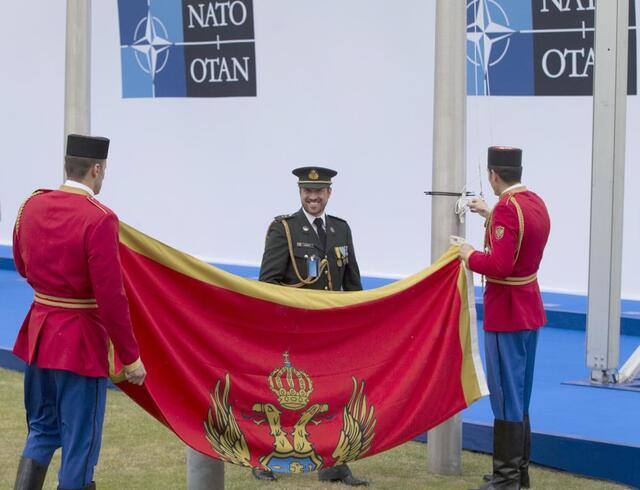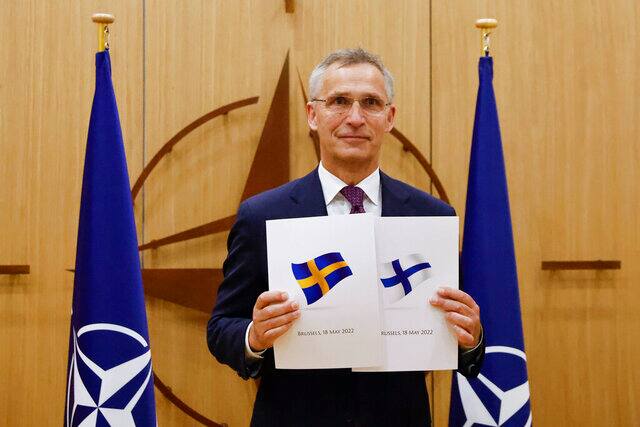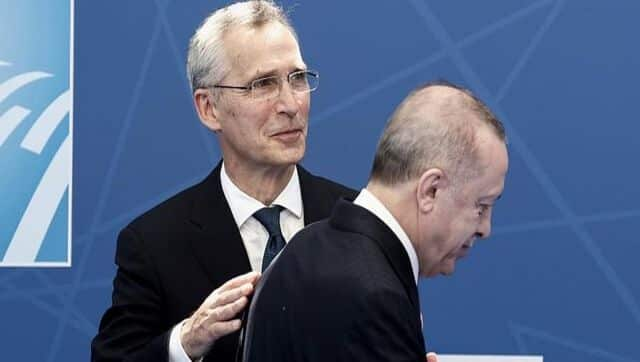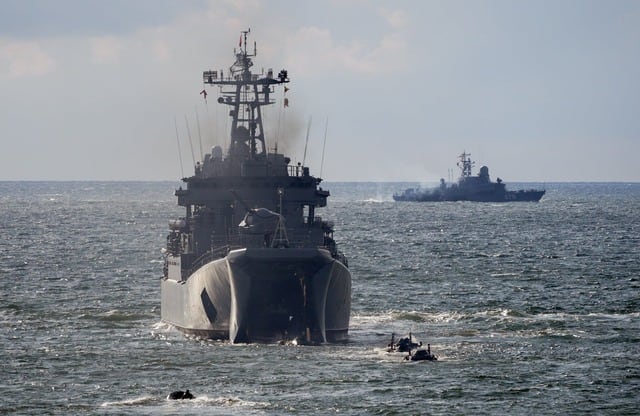The North Atlantic Treaty Organization (NATO) was formed in 1949 by 12 founding members, including the US, the UK, Canada and France. Its members agreed to help one another if they come under armed attack. The original aim was to counter the expansion of the erstwhile Soviet Union in Europe after World War II. It has been expanded a number of times, the first additions being Greece and Turkey in 1952. In May 1955, West Germany joined NATO. Following the end of the Franco regime, Spain joined NATO in 1982. [caption id=“attachment_10806971” align=“alignnone” width=“640”]  Secretary of State Dean Acheson signs the Atlantic defense treaty for the United States, 4 April, 1949. Vice President Alben W Barkley, left, and President Harry Truman converse during the signing. AP File[/caption] In 1990, the Soviet Union and NATO reached an agreement that a reunified Germany would join NATO under West Germany’s pre-existing membership, although restrictions were agreed to on the deployment of NATO troops on former East German territory. Following the Soviet Union’s collapse in 1991, many of its former Eastern European allies joined NATO. Poland, Hungary, and the Czech Republic became NATO members in 1999. NATO then formalised the process of joining the organisation with “Membership Action Plans”, which aided the accession of seven Central and Eastern European: Bulgaria, Estonia, Latvia, Lithuania, Romania, Slovakia, and Slovenia. Albania and Croatia joined in April 2009. The most recent member states to join NATO were Montenegro on 5 June 2017 and North Macedonia on 27 March 2020. [caption id=“attachment_10807001” align=“alignnone” width=“640”]  Soldiers from Montenegro unfurl the national flag during a ceremony to mark the accession of Montenegro at NATO Headquarters in Brussels on 7 June, 2017. AP File[/caption] NATO’s door remains open to any European country in a position to undertake the commitments and obligations of membership, and contribute to security in the Euro-Atlantic area. It’s Article 5, arguably the most consequential clause, states that “the parties agree that an armed attack against one or more of them in Europe or America shall be considered an attack against them all,” and in such an event, each of them would exercise the right of individual or collective self-defence. The process of joining the alliance is governed by Article 10 of the North Atlantic Treaty, which allows for the invitation of “other European States” only, and by subsequent agreements. Countries wishing to join must meet certain requirements and complete a multi-step process involving political dialogue and military integration. It can take a year to apply and become a member, and all member states must agree that a new country can join. With Finland and Sweden now wanting to join NATO, it would take the total number to 32 members. Both countries have been neutral for many years. However, public support for joining NATO has grown since Russia invaded Ukraine. [caption id=“attachment_10807131” align=“alignnone” width=“640”]  NATO Secretary-General Jens Stoltenberg displays documents as Sweden and Finland applied for membership in Brussels, Belgium, 18 May, 2022. AP File[/caption] However, Turkey says it will refuse to let in either Sweden or Finland. Turkish President Recep Tayyip Erdogan has stated that the two countries have been harbouring members of the Kurdistan Workers’ Party (PKK), a group it views as a terrorist organisation. However, the US says that it is confident Finland and Sweden will both join, despite Turkish objections. For much of the Cold War, Finland’s relationship with NATO and the Soviet Union followed the Paasikivi-Kekkonen doctrine, where the country joined neither the Western nor Eastern blocs, and limited its military activities. It aimed at Finland’s survival as an independent sovereign, democratic, and capitalist country in the immediate proximity of the Soviet Union. Since the 1990s and across multiple governments, the Finnish position was that joining NATO was unnecessary and it was preferable to retain an independent defence policy. During the Finnish presidential election of 2006, the possibility of Finland’s membership in NATO was one of the most important issues, and has continued to be a significant issue in Finnish politics. Following the Russian invasion of Ukraine, Finland and Sweden had attended the emergency NATO summit as members of NATO’s Partnership for Peace and both had condemned the invasion and had provided assistance to Ukraine. On 17 May, the Parliament of Finland voted 188–8 in favour of joining NATO. This is also an indicator of how much opinion in Europe has shifted against Russia since it invaded Ukraine. A formal application was submitted for NATO membership on 18 May 2022. If Finland is accepted, its 1,340 km (830 mile) border will become NATO’s longest boundary with Russia, more than doubling the length of Europe’s front line. In 1949, Sweden chose not to join NATO and declared a security policy aiming for non-alignment in peace and neutrality in war. This position was maintained during the Cold War. Since the 1990s, however, there has been an active debate in Sweden on the question of NATO membership in the post-Cold War era. Russia’s military actions have now led to most major political parties in Sweden to re-evaluate their positions on NATO membership, and many support Swedish membership. The ruling Swedish Social Democratic Party announced on 15 May 2022 that it would now support an application to join the organisation. In coordination with neighbouring Finland, a formal application was submitted on 18 May 2022, despite Russian threats of “military and political consequences”. Sweden’s Gotland Island in the middle of the Baltic Sea would no doubt give NATO a strategic advantage. While most current NATO members responded positively to the application, Erdoğan voiced his opposition, accusing both Sweden and Finland of tolerating groups which Turkey classifies as terrorist outfits. He said, “Giving all kinds of support to the PKK/YPG terrorist organization and also asking us for support for NATO membership is, to say the least, inconsistent.” [caption id=“attachment_10807201” align=“alignnone” width=“640”]  NATO Secretary General Jens Stoltenberg, left, greets Turkey’s President Recep Tayyip Erdogan as he arrives for a NATO summit at NATO headquarters in Brussels. AP File[/caption] On 20 May, Swedish Minister of Foreign Affairs Ann Linde pushed back against Erdoğan’s claim, calling it “disinformation”. He stated that “due to the vastly spread disinformation about Sweden and PKK, we would like to recall that the Sweden Government of Olof Palme was first after Turkey to list PKK as a terrorist organisation, already in 1984,” and noted that the EU “followed suit” in 2002. Secretary of State Antony Blinken said that there is “very strong consensus” for bringing Finland and Sweden into the alliance, despite a threat by Turkey to block them. Finland and Sweden have little in common with the countries that joined NATO since the end of the Cold War. They are not new democracies seeking incorporation into European structures, rather they are highly developed market economies and longstanding members of the European Union. They also have significant capabilities and resources that will be an addition to NATO. Maybe they feel they need the guarantee of NATO security post the Ukrainian invasion. Europe will face a fundamentally changed security environment once NATO embraces Sweden and Finland, which together form a strategic landmass. They also lie in the Baltic Sea and the presence of a NATO naval base in this strategic area will no doubt be visualised as a direct threat to the Russian Baltic fleet. Membership of NATO by these countries will also result in more focus being given to the Arctic region as a zone of competition with Russia as a wide range of military and non-military concerns revolve around the Arctic for all the countries involved. However, Prime Minister Sanna Marin said that “nobody will come to us to impose nuclear weapons or permanent bases on us if we don’t want them,” and “it does not seem to me that there is even interest in deploying nuclear weapons or opening NATO bases in Finland”. Swedish Prime Minister Magdalena Andersson has also said her country does not want permanent NATO bases or nuclear weapons on its territory. But the development of military infrastructure will no doubt be of concern to Russia. George F Kennan, the architect of the US’ “containment” strategy to isolate the Soviet Union, in an op-ed for the Times, in 1997, had warned that NATO expansion after the Soviets’ demise “would be the most fateful error of American policy in the entire post-Cold War era”. It could inflame nationalist, anti-Western, and militaristic tendencies in Russia, have an adverse effect on nascent Russian democracy, and hinder arms-control agreements. Former US Defence Secretary Robert Gates, while talking of the Ukrainian invasion, termed it a huge miscalculation by President Vladdimir Putin: “So, I think one of his many, huge miscalculations in invading Ukraine is he has dramatically changed the geostrategic posture of Western Europe. And now that you have the Swedes and the Finns as part of that, he’s really put Russia in a much worse strategic position than it had before the invasion.” But there are others who feel that the desire to humiliate Putin and reinforce US global military dominance is short sighted and dangerous. It risks escalating, expanding, and prolonging the war in Ukraine. Expansion of NATO to Russia’s northern borders is a provocation that will only raise the stakes in the Ukraine war and make it more difficult for Putin to back down. It was a mistake to incorporate the former Warsaw Pact countries into NATO after the end of the Cold War, as many leading analysts and policymakers argued at the time, and it ultimately served to reinforce Russia’s sense of isolation and encirclement. [caption id=“attachment_10807301” align=“alignnone” width=“640”]  An amphibious landing exercise was held by naval infantry units of the Russian Baltic and Northern Fleets in the Baltic Sea in August 2021. The New York Times[/caption] Bringing Sweden and Finland into the NATO fold will significantly mitigate the alliance’s biggest military vulnerability, which is the exposed geography of the Baltic states. There is no doubt that the implication is that Russia will now have to give military attention to its north-western flank. The author is an Army veteran. Views expressed are personal. Read all the Latest News , Trending News , Cricket News , Bollywood News , India News and Entertainment News here. Follow us on Facebook, Twitter and Instagram.
There’s a feeling that the desire to humiliate Vladimir Putin and reinforce US global military dominance is short-sighted and dangerous. It risks escalating, expanding, and prolonging the ongoing war in Ukraine
Advertisement
End of Article


)

)
)
)
)
)
)
)
)



